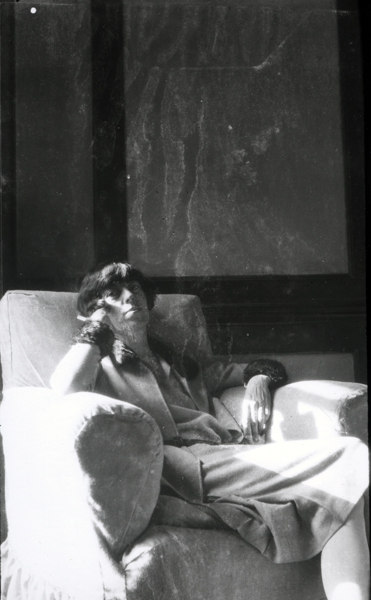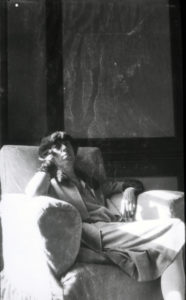Evelyn Scott
Evelyn Scott began her literary career as a poet but expanded into other literary genres, including short stories, essays, novels, memoir, and drama.

Courtesy of University of Tennessee Libraries
Evelyn Scott. Unidentified
Evelyn Scott, who came of age in New Orleans, began her literary career as a poet but expanded into other literary genres, including short stories, essays, novels, memoir, and drama. She was an important figure in modernism, an artistic movement that flourished in the United States and Europe during the first three decades of the twentieth century. Perhaps best known for her trilogy of novels—The Narrow House (1921), Narcissus (1922), and The Golden Door (1925) —Scott railed against the conventions of southern culture. She was particularly critical of traditional ideals of southern white womanhood in her life and work.
Early Life
The only child of Seely and Maude Thomas Dunn, Evelyn Scott was born Elsie Dunn in Clarksville, Tennessee, on January 17, 1893. Seely Dunn lost money in various business schemes and, as the family’s money ran out, they moved from Kentucky to Indiana to Missouri before heading to New Orleans. In 1901, the Dunn family moved to New Orleans, seeking financial assistance from Evelyn’s paternal grandfather, Oliver Milo Dunn, who was superintendent of the New Orleans & Mobile division of the Central Illinois Railroad.
Scott’s education came mostly through the occasional private tutor and self-directed readings; brief stints at Newcomb Preparatory School and Newcomb Art School rounded out her intellect. Surrounded by books in the family’s library, Scott found it difficult to focus on one discipline. She yearned to write, paint, act, and study with Anna Pavlova, the Russian ballerina. Tolstoy, Nietzsche, Bergson, and Marx informed her philosophy.
The tense relationship between Scott’s parents made for turbulence in her teenage years. Seely Dunn found many opportunities for extramarital affairs in the permissive culture of New Orleans, while Scott’s mother, Maude, struggled to maintain the appearance of propriety. Defying her society’s expectations of the southern belle, Scott scoffed at the importance of virginity and was both repelled by and attracted to the men in her social milieu. Scott’s progressive ideas often offended her mother’s sense of decorum. Maude Dunn was mortified, for example, when Scott wrote a letter to the editor of the Times-Picayune advocating the legalization and regulation of prostitution to prevent the spread of venereal disease.
Despite her rejection of its traditional values, New Orleans inspired much of Scott’s early work. She published her first short story in the New Orleans Times-Picayune under the pen name Hiram Hagan Beck. The city’s steamy environments informed her next major work, a novel now lost, about a friendship between a prostitute and a young woman. Scott sent this novel to Dorothy Dix, a fellow native of Clarksville who also moved to New Orleans. Dix worked as a writer for the Times-Picayune and served as a role model of a working writer who also advocated women’s suffrage.
At seventeen, Scott joined the Louisiana Women’s Suffrage Party and served as its secretary. She quit, however, when she learned the group’s agenda was not as radical as her own. Other members of the party, for example, disagreed with her advocacy for outcasts and African Americans, as well as her embrace of Marxism.
By age twenty, Scott felt social pressure to marry and become a mother. While she sought to live a life of the mind, her parents urged her to marry a man who would support her, thus relieving them of a financial burden. Despite her family’s precarious financial situation, Scott rejected the option of traditional marriage, choosing instead to run away with an older, married man, Frederick Creighton Wellman. Though Wellman’s wife refused to grant him a divorce, Scott imagined their lives together as a grand adventure, during which she would be free of social codes, pressures, and the strict eye of her mother. On December 26, 1913, the couple boarded a train for New York City, where they assumed the names Evelyn and Cyril K. Scott, a married couple. Thereafter Elsie Dunn was known as Evelyn Scott.
Because Scott was just shy of her twenty-first birthday, Wellman broke the law by crossing state lines with her. When his wife threatened to sue, and Seely Dunn employed several agencies locate the couple, they fled to Brazil, where they lived from 1913 to 1919. While in Brazil, Scott gave birth to a son, Creighton, and developed her literary skills. The couple returned to the United States in 1919 but continued to travel extensively. Her relationship with Wellman ended, however, in 1922.
Writing Career
Evelyn Scott published the majority of her work during the 1920s. The Narrow House was published in 1921; Narcissus and The Golden Door followed in rapid succession. This trilogy was followed by another consisting of the novels Migrations (1927), The Wave (1929), and A Calendar of Sin (1931). Scott spent the 1930s living in New York City until her marriage to British writer John Metcalfe. They lived in Canada and England until the 1950s, when she returned to the United States. Scott wrote her last book, The Shadow of the Hawk, in 1941. She died August 3, 1963.
Though critically acclaimed, Scott was not generally recognized as a southern writer. More often, she was seen as a modernist; her work was published alongside James Joyce and T.S. Elliot in Egoist, Poetry, Dial, and other literary journals. Key themes of her work include orthodoxy and rebellion, the oppressive nature of the family, and the artist at war with society. Other writers championed her depictions of mixed-race characters as astute. Scott experimented with imagism, expressionism, stream of consciousness, and the psychological novel. She was an important literary and intellectual figure whose legacy was rediscovered at the end of the twentieth century.
